In a 3.16 lead piece called “9/11 Pitch Meeting,” I argued that the story behind the forthcoming Oliver Stone 9/11 movie, about a couple of Port Authority police officers named Will Jimeno and John McLoughlin who found themselves buried inside a small pit under 20 feet of rubble after the collapse of the North Tower, and were eventually found and dug out, isn’t nearly as intriguing as the story of Port Authority employee Pasquale Buzzelli. I’ve passed this along before…Buzzelli was the guy who was in a stairwell on the 22nd floor of the North Tower when it came crashing down and who somehow survived. (He awoke a couple of hours later on a concrete slab situated 30 feet above where Jimeno and McLoughlin were trapped.) Buzzelli’s story is ten times what Jimeno and McLoughlin’s is because of the surreal, full-throttle, hand-of-God quality of what happened to the guy…he’s almost the mythical “building surfer.” I’m mentioning this because Buzzelli’s story is one of many included in “102 Minutes,” the what-happened-inside-the-towers history by New York Times reporters Jim Dwyer and Kevin Flynn. Their book has been adapted into script form by Shattered Glass director Billy Ray for a possible film to be produced by Columbia-based Mike Deluca. Anyway, here’s the shot: before leaving Manhattan in late August I spoke to a friend who’s read a recent draft of Ray’s script and…my face turned ash-gray when I heard this…Buzzelli’s story isn’t in it. Don’t know if this is true, but if it is…?
In Glenn Whipp’s interview piece with Jodie Foster, she relates a story about seeing March of the Penguins with her two kids at a Sunday noontime matinee and getting into an argument with a woman who went “beserk” because one of her kids was talking in the usual piercing way that little kids talk and disturbing the vibe. “One son’s older, so he was quiet all the time, but my little one says things like, ‘Is that the baby? Is he carrying the egg?'” Foster relates. “And I’m trying to keep him quiet, but he’s not screaming or anything. He’s just asking questions, and kids don’t know how to talk quietly really. And this woman in front of me is just beserk. She started with the shushing from the get-go. ‘Fine. You can shush forever.” And then she starts yelling at me. Finally, I just turn into the most perfect police officer where I was whispering, ‘You know, you’re really disturbing everybody, and I think it would be a good idea if you moved if you’re not happy.’ It almost came to blows. I’m pretty sure I did say something offensive at some point, something like, ‘Well, you’re awfully young to be that bitter.'” I understand, I’ve been there, I went through it for years, but except for Foster’s contention that her adversary “lost her mind,” I’m afraid I have no choice but to side with beserko-lady. If your kids are yapping and you can’t keep them quiet, you have to leave the theatre. You have to respect that others paid the ten bucks to see the movie and that your kid is messing with their experience and that’s that…no two ways… Sunday matinee or not.
If you want a demonstration of how fair and thorough David Poland’s Movie City News is in terms of links to showbiz stories on its main page, click on it right now. (I wrote this Friday morning at 7:19 am.) The link at the top of the page says “Kilday On The Doc Race for Oscar…But Leaves Out A Lot Of Titles, Including Sony Classics’ Sundance Directing Winner The Devil & Daniel Johnston , Which Is Oscar Qualified.” And of course, naturally …you expected otherwise?…Poland ignored my lead piece on the exact same topic, which went up last night around 6:30 pm.

A friend who’s seen Martin Campbell’s The Legend of Zorro (Columbia, 10.28) says it runs something like two hours and fifteen minutes, give or take. If this sequel to Campbell’s The Mask of Zorro (1998) is anything like its sire, Legend is going to be throwaway crap. (The trailer gives you ample indication of same.) If you’re making a piece of glossy junk, it goes without saying you don’t let it run too long. 95 to 100 minutes…105 or 110 minutes, tops. You certainly don’t let it go as long as two hours, and anything longer than that would be burdensome beyond reason.
The Dangerous Lives of Altar Boys, Panic Room, A Very Long Engagement…you can’t help wondering why Jodie Foster agreed to star in Flightplan. Two-thirds of it is half decent, but what was the point? I’m told that the script, written by Peter A. Dowling and Billy Ray, has been kicking around for some time and that there was once a third-act resolution that involved terrorists. But the Islamic baddies were thrown out after 9.11 and eventually replaced with….here he comes!…aaahhh!….the former editor of The New Republic!
“There’s no black and white, left and right to me any more…there’s only up or down. And down is very close to the ground, and I’m trying to go up without thinking about anything trivial, such as politics.” — Bob Dylan, as quoted by Martin Scorsese in No Direction Home: Bob Dylan. I want Todd Haynes to succeed with I’m Not There: Suppositions on a Film Concerning Dylan, which is in pre-production, but how can suppositions of any kind compete with majestic echoes?

Regarding Violence
If you’ve seen David Cronenberg’s A History of Violence, you know it’s a philoso- phical double-dealer, and this is what makes it a complex, cut-above film. It’s not just saying violence is a kind of terrible virus — it’s also saying it has a way of turning us on.
When Jack (Ashton Holmes), the son of cafe owner Tom Stall (Viggo Mortenson), defuses a potentially violent encounter with a school bully by sarcastically acknow- ledging the other guy’s alpha male superiority, etc., you admire Jack for being a hip and clever guy.
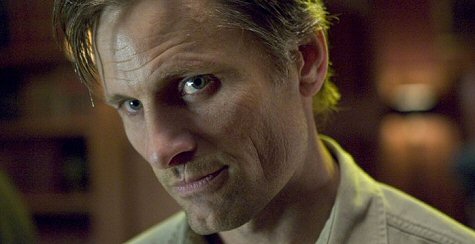
Viggo Mortenson as small-town nice guy Tom Stall in David Cronenberg’s A History of Violence
But when they meet a second time and Jack, inspired by his father’s having become a hero because he killed a couple of bad guys, wails on the bullies and leaves them bruised and groaning, several people in the theatre (at L.A.’s Grove plex) were clapping and whoo-whooing.
Is there anyone out there who thinks Cronenberg didn’t deliver this scene in just the right way so he would get this reaction?
And of course, the steam that comes hissing out of Edie Stall (Maria Bello) isn’t just about feelings of betrayal.
< ?php include ('/home/hollyw9/public_html/wired'); ?>
Edie is furious, naturally, when she realizes her husband has been lying to her for years about his past. But when she and Tom have that end-of-Act-Two fight and she goes “fuck you, Joey” and walks off and Tom grabs her by the ankle and they do that thing on the stairs (a scene that wasn’t scripted, by the way…it just “hap- pened” when they shot it), it’s obvious that Tom’s killer moves have lit a fire in someone’s furnace.
And yet the violence that has happened has obviously stunned and hurt this family of four. In that haunting final scene, Cronenberg shows us that Jack and his younger sister are willing to forgive and forget as they offer food to Tom, but there’s not much assurance that things will henceforth be fine…Cronenberg leaves us in limbo.
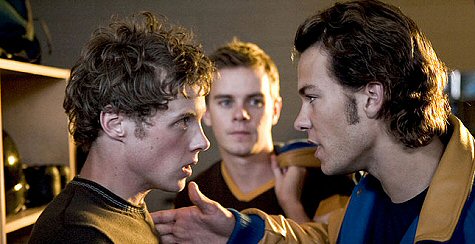
Jack Stall (Ashton Holmes) and the high-school baddies
That’s filmmaking, pally. Lob the ball to the audience in the final frame and let them sort it all out…nice.
One beef with this film: Peter Suschitzky’s cinemography looks like it was soaked in Bolivian coffee during lab processing. I started to wonder if the projector lamp at the Grove’s theatre #1 was dying, but the lamps in the other theatres were fine. The last film I remember being this muddy-looking was Fight Club.
Knockout
I liked so many films in Toronto I was looking forward to trashing two or three upon my return to Los Angeles. So to get things rolling I went to a screening last night (Thursday, 9.22) of Rodrigo Garcia’s Nine Lives (Magnolia) and…shit, another good one.
It’s nine interwoven shorts about women in relationships that aren’t really working, relationships they’d like to be rid of on one level but can’t quite extricate themsel- ves from, and what’s holding them.
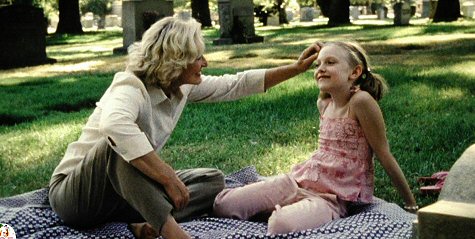
Glenn Close, Dakota Fanning in Rodrigo Garcia’s Nine Lives (Magnolia)
Each story is a part-muddle, part-riddle and a fascinating drill into some aroused places in the heart, and five out of the nine are direct hits.
I’ve now seen two dramas over the last week and a half about female turmoil and tough choices, but which operate well beyond the usual chick-flick realm….this and In Her Shoes.
Nine Lives played Sundance last January and then the L.A. Film Festival three months ago…why haven’t I heard anything? Am I alone on this one? I don’t care.
Once again we have a south-of-the-border director — Rodrigo Garcia, a colleague of the great Alejandro Gonzalez Innaritu — hitting the ball deep into left-center field and scoring a ground-rule double, if not a triple.
Nine Lives isn’t quite a homer but it’s much better than I expected. It has that same connective-tissue, life-is-short, death-is-just-around-the-corner thing that we’ve all gotten to know through Innaritu’ Amores Perros and 21 Grams.
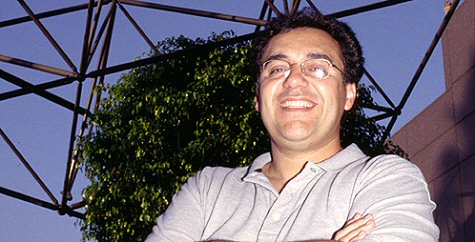
Nine Lives director-writer Rodrigo Garcia
Neither Innaritu or his screenwriting partner Guillermo Ariagga (who also wrote The Three Burials of Melquiades Estrada) have a co-writing credit, but they might as well have. Garcia is clearly coming from the same place…another Mexican heavy- cat soul man.
Garcia’s writing and the acting are exceptional all through it, and there are two pieces in particular about obsessive sexual love that knocked me on the floor.
The best of the two costars Robin Wright Penn and Jason Isaacs. Set entirely in the aisles of an L.A. supermarket, it’s a marvel of tight writing, dancing camera work, perfectly-pitched acting and emotional sizzle.
The other is a fascinating piece about a woman (Amy Brenneman) and her father attending a funeral of a woman who’s committed suicide, and the soon-enough realization that the woman is a former wife of the deceased woman’s deaf husband (William Fichtner), and that their attraction is not only still going on but may have pushed the wife into suicide, and that their feelings are so urgent that Brenneman and Fichtner can’t help finding a private room and closing the door.
I don’t know which of the two is more of a jaw-dropper, but together they’re worth the admission, the popcorn and having to watch the ads before the trailers.
There are at least three other strong entries. About a financially struggling, clearly frustrated 40ish couple (Stephen Dillane, Holly Hunter) visiting a couple (Isaacs again, Molly Parker) they believe to be on a happier, more comfortable plane. About a terrified wife (Kathy Baker) preparing for breast-removal surgery and bitching at her husband (Joe Mantegna) as she works through her feelings. And about a loving mother (Glenn Close) and her young daughter (Dakota Fanning) visiting a graveyard.
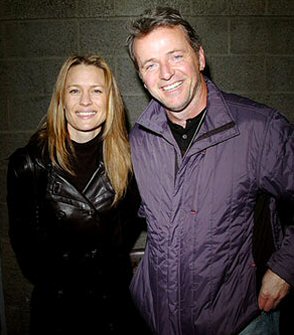
Nine Lives costars Robin Wright Penn, Aidan Quinn at last January’s Sundance Film Festival
The cast also includes Elpidia Carillo, Lisa Gay Harden, Ian McShane, Mary Kay Place, Sydney Tamiia Poitier, Aidan Quinn, Miguel Sandoval, Amanda Seyfried and Sissy Spacek.
The other four are decent, good enough, carry the ball, etc. A movie like this is like a relay race. Not every segment can bring the fans to their feet.
Nine Lives will open in Los Angeles and New York on 10.14, and will start fanning out the following week.
Moonlighting
After seeing A History of Violence at the Grove, I went to see Kate Krystowiak’s Aftermath, a 28-minute short that she stars in and wrote the script for, at the Laemmle Fairfax last night (9.24).
An above-average effort, it’s an emotionally upfront piece about a romantically impressionable woman named Sara who suffers an emotional bruising from an attractive young guy who moves into her place. The hurt is a result of your typical modern-asshole-boyfriend tendencies (egotism and an inability to share intimacy, for the most part), but also from Sara’s willingess to turn a blind eye at the get-go.
Aftermath could stand some tightening and re-shuffling here and there (film festi- vals don’t like shorts that aren’t 15 minutes long or less), but the hurt that comes out of Krystowiak’s Sara character feels very real.

Aftermath editor Teresa Bianca Sciortino, star-writer Kate Krystowiak at Guys — Saturday, 9.24, 12:25 am. The film’s director, Jon Palardis, is visible to the left.
There are two things missing: hot sex and empathy for Sara. There’s a revelation near the end that the boyfriend (Charlie Capen) talked about himself incessantly during their first date and didn’t ask Sara a single question….hello? This is the kind of guy a girl might want to rape or have an affair with, but move in with…?
An audience will empathize with the participants in an ill-fated relationship if it’s about fantastic Olympic-level schtupping, but it’s hard to put yourself in the shoes of a character who ignores warning signs as blatant as the one referred to at the end of this film…sorry, but that’s a fact.
Krystowiak has a quality when she’s confident enough to just be still and let what seems like a kind of natural Polish sadness in her leak out. She needs to just “be.” She has a kind of eastern-European, slightly off-pretty soulfulness…and the less she smiles and tries to sell her perkiness, the more this comes through.
Krystowiak needs to be brought out by a director with the chops of a Krzysztof Kieslowski or a Jerzy Skolimowski. She could have nailed Jane Asher’s part in Deep End, or been the sensuous-girlfriend-in-the-TV-screen in Skolimowski’s Moonlighting.
There was an okay after-party at Guys, a bar right between Jerry’s Deli and Dom- inick’s on Beverly near San Vicente. $10 bucks to get in, $10 bucks a drink… fuck…but it’s mostly an outdoor back-patio thing and I’d be lying by omission if I didn’t say that a very high percentage of the women were drop-dead gorgeous.
Where’s the Bite?
The Academy people who will vote for the Best Feature Doc are thought to be into “bite.” Okay…but how does that square with the general feeling that March of the Penguins, a doc so without bite it could be said to be all gums, is favored to win?
And if weren’t for this ice-frosted Waiting-for-Godot movie, the big favorite would probably be Mad Hot Ballroom, and how “bite” is that? Cute fifth-graders learning to dance and romance and grow up…?

Murderball
I know it’s a crying shame that Eugene Jarecki’s Why We Fight, my hands-down choice for the year’s best documentary, is out of the game in part because it aired twice on England’s BBC 4 on 3.23.05.
A brilliant summation on the militant tendencies of U.S. foreign policy over the past 60 years, Why We Fight had a one-week Academy qualifying run in a Marina del Rey theatre last August, and the Academy rulebook states that “no type of tele- vision or internet transmission shall occur at any time prior to the first day of the Qualifying Exhibition”…so that’s that.
I’ve heard that Jarecki has an argument with the Academy…something about a vaguely-worded announcement about a rule-change, which led to a misunder- standing about the allowability of the BBC airing…or some such shit. I called Jarecki four times yesterday to get into it, but he didn’t get back.
On Friday morning I read in a Gregg Kilday piece in the Hollywood Reporter that Why We Fight has also “been ruled ineligible because it has had at least three TV airings in Norway, Sweden and Finland.”
What other docs might wind up nominated? I mean, if you give a shit about this stuff. I’m right on the verge of not caring. It’s also my life, my strife…I shouldn’t admit to this.
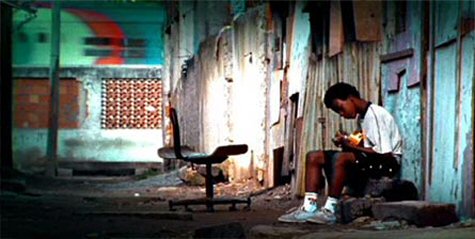
Favela Rising
Naturally, obviously, incontestably…Penn Jillette and and Paul Provenza’s The Aristocrats, a doc that people saw and got all over and kept playing and playing, mainly (I think) because it works on at least three different levels, being (a) funny, (b) appalling and yet a surprisingly warm “family film,” and (b) an educational riff about the nature of creativity. It was such an obvious choice I forgot to put it into this piece when I wrote it late yesterday.
I also forgot to mention Werner Herzog’s Grizzly Man (Lion’s Gate)…I must have a screw loose. It’s only one of the year’s best films bar none.
Alex Gibney’s Enron: The Smartest Guys in the Room…right? Smart, sharp, hard-driving, amusing…important subject, well-reviewed…gotta be there.
And Murderball, of course. Original, intense, fierce…the rumble spreading for the last few months…it’s sunk in to the level where even Academy people are hearing it…Murderball-it.
And Marc Levin’s Protocols of Zion, a 93-minute doc about anti-Semitism and the post-9/11 scattershot blame game.
And David LaChappelle’s Rize, about the South Central dance thing…I guess. I’m not feeling the energy right now, but that’s just me.
A Brazilian doc called Favella Rising might cause a stir. It’s about a onetime drug-dealer named Anderson Sa who evolved into a kind of Malcolm X-like social revolutionary… leading a rebellion against “teenage drug armies and sustained by corrupt police,” blah blah….fine.
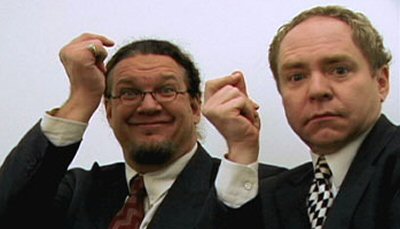
Penn and Teller delivering the now-infamous, staggeringly unfunny punch line.
And I’m told that Darwin’s Nightmare could register. A doc on the effect of fishing the predatory Nile perch in Tanzania’s Lake Victoria…hmmm. A metaphor about voracious appetites of all shapes and origins.
If Martin Scorsese’s No Direction Home: Bob Dylan had cared to qualify itself (i.e., by playing in some obscure New York or Los Angeles theatre last March and then going with the PBS airing and DVD release six months later), it would almost certainly be one of the five. This is a film with bite, snap, brass and bazookas.
This Is Bad
I can’t overstate what a besotted, drugged-out feeling it is to be back in Los Angeles…to once again stand on the roof of a certain West Hollywood high-rise and smell the faintly noxious air and gaze out at the milky haze and tell myself, “It’s okay…despair not.”
There is only way to live in this town and that’s to crawl into the cave of your own head and your work, and to feed off screenings and DVDs and the faces and bodies of pretty women, and to savor those special times in which you happen to be in the company of similarly diseased and/or disgruntled persons like myself.
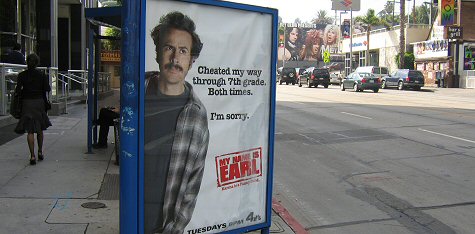
Sunset Boulevard in West Hollywood — Tuesday, 9.20, 1:40 pm.
Like, for instance, the amazing Joss Whedon.
I would find it astonishing to find myself in the pasta-and-sauces department of Pavilions and all of a sudden…Whedon! Just standing there in boring clothes like a regular mortal and telling himself, “I can’t eat pasta any more, certainly not in the evening. Face it — those days are over.”
A portion of my L.A. lethargy is indicated by the fact that I’m back to reading Defamer and going “hyeh-hyeh” like Beevis and Butthead. I didn’t go to Defamer once during the Toronto Film Festival, and not all that much when I was living in Brooklyn. I like Defamer — it’s a very well-written thing and a necessary component — but you have to be a little sick in your soul to be into it in the first place.
I could feel the old vibe swirling around me like that banshee from Darby O’Gill and the Little People, so I did the sensible thing and evacuated myself off the roof of the high-rise and made my way over to Tower Records and bought the DVD of No Direction Home: Bob Dylan.
I tried to wangle a freebie from the Paramount Home Video publicist who took Martin Blythe’s place, but she didn’t call back until today. I tried to buy it yesterday at Laser Blazer in the early afternoon, only to be told it had sold out. The Tower Video guys, who had plenty of copies, said it was moving moderately well but nothing to write home about.
I nodded off for about 20 minutes when I saw David Cronenberg’s A History of Violence in Cannes and I didn’t get around to it in Toronto, so tonight I get to absorb the whole thing at the American Cinematheque, more or less alert…down for it.

Looking due north from the roof of a condo building at Alta Loma and Holloway — Tuesday, 9.20, 8:45 am.
That means blowing off the all-media of Flightplan, but sometimes you just have to say no.
I’m a little surprised to be riffing rather indulgently about the stink of Los Angeles seeping back into my bones (that’s a Charles Bukowksi line), and I promise to get back into matters of substance fairly soon.
Except melancholia is a matter of substance if you live here.
I’ve got a screening conflict next Tuesday evening — Tony Scott’s Domino vs. Joss Whedon’s Serenity. Well, not really. I would be squirming a bit if Whedon and I were talking in the pasta-and-sauces aisle right now and he was asking me, “So, are you going?”…but we’re not so I’m cool.
The only thing that gives me concern about Domino is an observation in David Katz’s profile of Keira Knightley in the current issue of Esquire. He says that Domino is “a messy movie, often intentionally, often not.”
Turnaround
For years the notion of Catherine Keener being in this or that film was not, for me, a reason to celebrate. She always seemed to play users, takers, manipulators… usually more pissed off than not.
Not each and every time, but I know this impression started to take hold in the late ’90s. I liked her frustrated actress character in Living in Oblivion back in ’96, but I remember going “whoa” after she played the heartless Maxine in Being John Malkovich.
I forget how many other razor-blade women she played in other films, but it seemed as if there were more than a few.

Capote costar Catherine Keener.
Now I feel rather differently, and all due to Keener’s last four roles — Daniel Day Lewis’s would-be signficant other in The Ballad of Jack and Rose, the quip-smart government agent in The Interpreter, Steve Carell’s sweet, spiritually-centered love interest in The 40 Year-Old Virgin, and Harper Lee, Truman Capote’s patient, all-seeing best friend, in Capote.
The Capote performance ought to result in a Best Supporting Actress nomination. It really and truly should — I can’t imagine anyone saying “no, I disagree” — and not just because Keener is so moving and touching in this role, but because of her image change.
I’m presuming I’m not the only person with this impression. Keener has always been a “good” actress, but now I think of her in terms of who I perceive her to be possibly be, based on an amalgam of the last four roles.
I was thinking of mentioning this during last night’s discussion at the Los Angeles County Museum’s Leo S. Bing Theatre after a screening of Capote, but it seemed too kiss-assy.
Keener, looking great, was sitting there along with her Oscar-worthy cohorts — director Bennett Miller, Philip Seymour Hoffman (a lock for Best Actor), Clifton Collins, Jr. (near-lock for Best Supporting Actor), and screenwriter Dan Futterman (ditto in the Best Adapted Screenplay category).
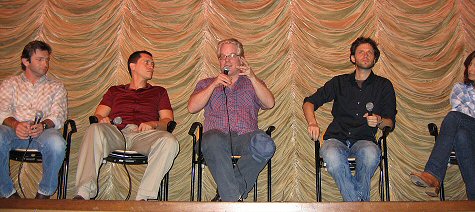
(l. to r.) Capote screenwriter Dan Futterman, star Philip, costar Clifton Collins, Jr., star Philip Seymour Hoffman, director Bennett Miller, and a portion of costar Catherine Keener at L.A. County Museum’s Leo S. Bing theatre — Tuesday, 9.20, 9:50 pm.
LACMA’s film department head Ian Birnie asked each a single question, and then asked the audience to chime in.
I asked Hoffman and Miller if they had somehow tried to suggest that Hoffman, who’s about 5’10” or so in real life, was closer to Truman Capote’s height of 5’2″. It sure seems this way in the film. They ignored my question, but Miller delivered a good line: “Philip lost 40 pounds and 4 inches for this role.”
I also asked about a little kid whom Capote happens to notice during a brief visit to a grocery store. About three years old, the kid has a toy pistol and does a kind of Diane Arbus-y routine for Capote with two or three grotesque expressions. Miller said this scene was some kind of tribute to Arbus….whatever.
A woman friend who came with me called Capote “one of the best films I’ve ever seen.” It sure as shit is one of the best of the year, a fact expected to be acknow- ledged by the Academy.
Wait a minute…have I said this before?
Shrinking Hoffman
“Since the Capote panelists didn’t answer your question about making Philip Seymour Hoffman appear shorter for his role, I thought I’d offer the following tidbit from our October issue, which offers insights from cinematographer Adam Kimmel:
“‘One overriding concern occupied the filmmakers from start to finish: how to make Hoffman appear as petite as Capote,” it reads. “The actor is 5 or 6 inches taller than the 5’ 2” Capote, and has a broader physique.
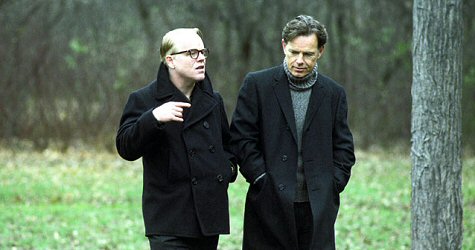
Capote
“‘In testing and during our first week of shooting, we learned which combination of wardrobe, lenses and framing would make Phil appear smaller,’ says Kimmel. ‘To help with the illusion, the actors who shared the frame with Hoffman frequently stood on boxes during stationary scenes, or walked on small, elevated platforms during walk-and-talks.
“The first time Capote and Lee see the Clutter farm, they are shown in a wide shot, with their backs to the camera. Keener, who is roughly the same height as Hoffman, is standing on a box that added 4″ to her height.” — Stephen Pizzello, Executive Editor, American Cinematographer.
Dylan/Scorsese
“You hit it with your words on the Dylan documentary. It’s a great portrait of America by Scorsese, an indisputable version of why Dylan had to crash at the end of that period, and a true inspiration for all of us to keep on and to keep on creating (Dylan being a real example of James Joyce’s description of an artist, one who has to live by ‘cunning and exile.’)
“I’ve been lucky to see Dylan perform a lot, from his comeback tour with The Band in ’75 (still one of the best shows ever) to all three nights that he played last Spring here in St. Louis at a small venue. (Lots of people came to that out of curiousity and were stunned by the music — you could see their respect and joy grow throughout those evenings.)

“He’s an endless source of a rock ‘n roll beat and a poetic charge. I have a new favorite lyric – from one of his songs I didn’t know, ‘Up To Me,’ which is covered on a recent tribute album by Roger McGuinn — ‘I’ve only smiled once in 14 months and I didn’t do it consciously.’
“But along with the interviews in No Direction Home, some of his utterances knock me out as well. When questioned why he agreed to appear along with his sacred music in, of all things, a Victoria’s Secret commercial, he reportedly said, ‘Was I not supposed to do that?'” — Joe Hanrahan.
This Is Bad
I can’t overstate what a besotted, drugged-out feeling it is to be back in Los Angeles…to once again stand on the roof of a certain West Hollywood high-rise and smell the faintly noxious air and gaze out at the milky haze and tell myself, “It’s okay…despair not.”
There is only way to live in this town and that’s to crawl into the cave of your own head and your work, and to feed off screenings and DVDs and the faces and bodies of pretty women, and to savor those special times in which you happen to be in the company of similarly diseased and/or disgruntled persons like myself.

Sunset Boulevard in West Hollywood — Tuesday, 9.20, 1:40 pm.
Like, for instance, the amazing Joss Whedon.
I would find it astonishing to find myself in the pasta-and-sauces department of Pavilions and all of a sudden…Whedon! Just standing there in boring clothes like a regular mortal and telling himself, “I can’t eat pasta any more, certainly not in the evening. Face it — those days are over.”
A portion of my L.A. lethargy is indicated by the fact that I’m back to reading Defamer and going “hyeh-hyeh” like Beevis and Butthead. I didn’t go to Defamer once during the Toronto Film Festival, and not all that much when I was living in Brooklyn. I like Defamer — it’s a very well-written thing and a necessary component — but you have to be a little sick in your soul to be into it in the first place.
< ?php include ('/home/hollyw9/public_html/wired'); ?>
I could feel the old vibe swirling around me like that banshee from Darby O’Gill and the Little People, so I did the sensible thing and evacuated myself off the roof of the high-rise and made my way over to Tower Records and bought the DVD of “No Direction Home: Bob Dylan.”
I tried to wangle a freebie from the Paramount Home Video publicist who took Martin Blythe’s place, but she didn’t call back until today. I tried to buy it yesterday at Laser Blazer in the early afternoon, only to be told it had sold out. The Tower Video guys, who had plenty of copies, said it was moving moderately well but nothing to write home about.
I nodded off for about 20 minutes when I saw David Cronenberg’s A History of Violence in Cannes and I didn’t get around to it in Toronto, so tonight I get to absorb the whole thing at the American Cinematheque, more or less alert…down for it.

Looking due north from the roof of a condo building at Alta Loma and Holloway — Tuesday, 9.20, 8:45 am.
That means blowing off the all-media of Flightplan, but sometimes you just have to say no.
I’m a little surprised to be riffing rather indulgently about the stink of Los Angeles seeping back into my bones (that’s a Charles Bukowksi line), and I promise to get back into matters of substance fairly soon.
Except melancholia is a matter of substance if you live here.
I’ve got a screening conflict next Tuesday evening — Tony Scott’s Domino vs. Joss Whedon’s Serenity. Well, not really. I would be squirming a bit if Whedon and I were talking in the pasta-and-sauces aisle right now and he was asking me, “So, are you going?”…but we’re not so I’m cool.
The only thing that gives me concern about Domino is an observation in David Katz’s profile of Keira Knightley in the current issue of Esquire. He says that Domino is “a messy movie, often intentionally, often not.”
Turnaround
For years the notion of Catherine Keener being in this or that film was not, for me, a reason to celebrate. She always seemed to play users, takers, manipulators… usually more pissed off than not.
Not each and every time, but I know this impression started to take hold in the late ’90s. I liked her frustrated actress character in Living in Oblivion back in ’96, but I remember going “whoa” after she played the heartless Maxine in Being John Malkovich.
I forget how many other razor-blade women she played in other films, but it seemed as if there were more than a few.

Capote costar Catherine Keener.
Now I feel rather differently, and all due to Keener’s last four roles — Daniel Day Lewis’s would-be signficant other in The Ballad of Jack and Rose, the quip-smart government agent in The Interpreter, Steve Carell’s sweet, spiritually-centered love interest in The 40 Year-Old Virgin, and Harper Lee, Truman Capote’s patient, all-seeing best friend, in Capote.
The Capote performance ought to result in a Best Supporting Actress nomination. It really and truly should — I can’t imagine anyone saying “no, I disagree” — and not just because Keener is so moving and touching in this role, but because of her image change.
I’m presuming I’m not the only person with this impression. Keener has always been a “good” actress, but now I think of her in terms of who I perceive her to be possibly be, based on an amalgam of the last four roles.
I was thinking of mentioning this during last night’s discussion at the Los Angeles County Museum’s Leo S. Bing Theatre after a screening of Capote, but it seemed too kiss-assy.
Keener, looking great, was sitting there along with her Oscar-worthy cohorts — director Bennett Miller, Philip Seymour Hoffman (a lock for Best Actor), Clifton Collins, Jr. (near-lock for Best Supporting Actor), and screenwriter Dan Futterman (ditto in the Best Adapted Screenplay category).

(l. to r.) Capote screenwriter Dan Futterman, star Philip, costar Clifton Collins, Jr., star Philip Seymour Hoffman, director Bennett Miller, and a portion of costar Catherine Keener at L.A. County Museum’s Leo S. Bing theatre — Tuesday, 9.20, 9:50 pm.
LACMA’s film department head Ian Birnie asked each a single question, and then asked the audience to chime in.
I asked Hoffman and Miller if they had somehow tried to suggest that Hoffman, who’s about 5’10” or so in real life, was closer to Truman Capote’s height of 5’2″. It sure seems this way in the film. They ignored my question, but Miller delivered a good line: “Philip lost 40 pounds and 4 inches for this role.”
I also asked about a little kid whom Capote happens to notice during a brief visit to a grocery store. About three years old, the kid has a toy pistol and does a kind of Diane Arbus-y routine for Capote with two or three grotesque expressions. Miller said this scene was some kind of tribute to Arbus….whatever.
A woman friend who came with me called Capote “one of the best films I’ve ever seen.” It sure as shit is one of the best of the year, a fact expected to be acknow- ledged by the Academy.
Wait a minute…have I said this before?
Grabs
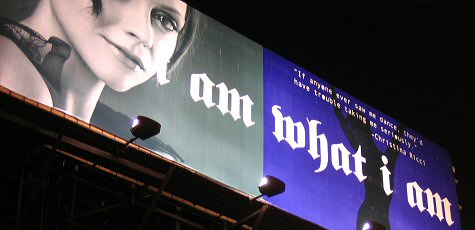
Billboard above Viper Room — Tuesday, 9.20, 10:50 pm.

Another depressing landscape.

Self-explanatory — Tuesday, 9.20, 10:45 pm.

Aboard Northwest Airlines #1411, Memphis to Los Angeles — Monday, 9.19, 5:50 pm.
Kings
“I’ve seen Steve Zallian’s All The King’s Men, and it felt to me like a very mature, richly adult political drama that carries considerable end-of-year pedigree.
“Major kudos, first and foremost, to Zallian for his subtle way of telling a story. All too often in telling convoluted, multilayered stories of this kind, filmmakers rely on excessive exposition to make sure that anyone can follow the plot without having to pay too much attention.
“Zallian goes the other route — details and plot twists are implied rather than explained, and this technique affords the film much more credibility.
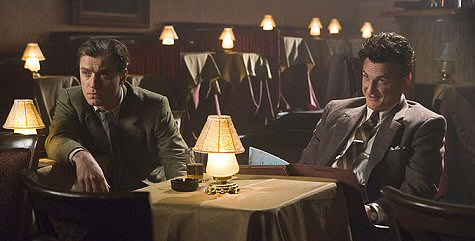
Jude Law, Sean Penn in Steven Zallian’s All The King’s Men
“Performances are strong all around, though Tony Soprano.. er, James Gandolfini struggles a bit with his Southern accent.
“There are two leads, Sean Penn’s Willie Stark — a wildly passionate and utterly corrupted Southern governor — and Jude Law as a tortured and crestfallen reporter named Jack Burden.
“Penn seems to be a much stronger contender for your Best Actor Oscar balloon. He delivers exactly what Academy voters are thought to love, giving a bombastic, almost Pacino-esque performance. And yet I would be much more excited to see Law’s performance be rewarded come awards season.
“And Zallian’s camera work compliments his sophisticated script nicely.
“What was shown was a work in progress (visually grainy, using pieces of the musical scores from Fargo and The Shawshanbk Redemption, to be sure, but one that shows significant promise.” — John McGilicutty
Down by Whedon
“In response to your Wired item about Joss Whedon, my first advice to you is this: as you prepare to rip or praise him in whatever fashion you intend, remember to tread very, very lightly.
“The man’s fan base is as rabid as that for any geek property out there, and if you do decide to trash him, you should be prepared for hate mail on the level of whatever Star Wars or Lord of the Rings flaming you’ve received over the years.
“Now, that being said, the idea of ‘getting’ Whedon is not something you will be able to do from just watching Serenity. It’s an impossibility.

From Joss Whedon’s Serenity
“The film is a continuation of a TV show that only a small but very devoted group of people watched in its original incarnation and more discovered later on DVD. Whedon’s appeal cannot and will not be understood by those coming to the film cold which, I feel, will kill it financially. If it does manage to catch on beyond the fan base, then great. But I don’t think anybody, beyond his most ardent followers, is expecting much.
“As for critics and columnists (like yourself) who are coming to the film cold, I fear that the response will be mixed to negative, as they will be reviewing the film on its own merits and not as a part of the larger whole. There is nothing wrong with this — it is their job. The best thing I can say to them and you is please, go easy.
“Serenity is a gift to Whedon’s fans, to provide closure on a TV series that they watched and enjoyed and which was snatched from them far too soon. I feel that a theatrical film was absolutely the wrong way to go on this, and that the property would have been much better off in a miniseries or TV movie on the Sci-Fi channel, in hopes of finding a new TV life.
“But Universal is taking a chance on Whedon and I truly hope that it works out for them.
“As for ‘getting’ Whedon, there’s really not much to get beyond the fact that the man has produced some great, great television (Buffy the Vampire Slayer and its spinoff Angel).
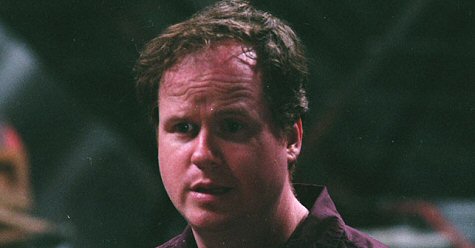
Serenity creator Joss Whedon
“His appeal can be gleaned from the fact that he takes high-concept approaches to well-worn genre shows (in Firefly’s case, the space opera and the western), fills them with sparkling wit and humor, and populates them with real, fully-dimensional characters that think and feel and hurt, where actions have real consequences and tragedy doesn’t always beget triumph.
“For years, Whedon managed to do the impossible in creating TV that didn’t take itself too seriously while, at the same time, taking itself absolutely seriously. He elevated genre television in the same way that David Chase elevated dramatic television with The Sopranos. This is what his fans reacted to, and why they continue to follow him into whatever avenue he chooses to pursue. I proudly count myself among them.
“Jeff, I don’t see you as the kind of person who will see Serenity, and rush out to pick up any of Whedon’s TV work on DVD, but this is really the only way to understand his appeal. The movie itself won’t do it. Just don’t judge the man on this film alone (or his spotty film record thus far). It’s not fair to him or to the fans that respect him.” — Mark of Boston, Mass.

East side of Broadway and 44th street, looking north — February 1963.
With Serenity due to open in ten days, I can feel the words taking shape in my head: “Get Joss Whedon.” (Yesterday’s misspelling was unfortunate, I agree.) Does this mean we should try and “get” Whedon in the sense of trashing his movie, fixing his game, beating him up in an alley, etc.? Not necessarily. Does it mean we should try to really get Whedon in the sense of arriving at a more profound understanding of who this ultra-crafty guy really is and what his wowser films are about deep down? I’m not certain. Thoughts?

Writing about Bubble, a certain columnist has said, “Steven Sodebergh’s most recent experiment has journalists with no actual depth of insight who were outraged by previous experiments flip-flopping and somehow embracing this one…and vice versa.” That’s a direct reference to, among I-don’t-know-how- many-others, myself…I’m one of those “with no actual depth of insight.” I don’t know how to say it in a limited space, but Bubble is (a) not as whack-cool as Soderbergh’s Schizopolis but (b) it’s way, way cooler than Full Frontal, which put Soderbergh into the critical doghouse. I could watch it another four or five times easily, but I don’t think I want to see Solaris ever again.
The Guardian‘s John Patterson hates Madonna and Guy Ritchie… whatever…but his 9.17 tear-down piece is wrong about two things: (1) Madonna’s palatial home near the Hollywood Reservoir was not in Silver Lake and didn’t even border on it — it was adjacent to Beachwood Canyon and is therefore smack dab in Hollywood; and (2) his observation that Madonna had to be “either terribly thick-skinned or terribly thick-headed” by continuing to make movies “after the quadruple-whammy of Shanghai Surprise, Body Of Evidence, Four Rooms and Evita” is 75% correct. Evita is a completely honorable and (for me) curiously touching film. I’ve seen it over and over on DVD, and it’s gotten a bit more rapturous each time. It’s one of Alan Parker’s finest films ever (certainly his most beautifully filmed), and say what you will about Madonna’s innate acting abilities but she’ll never be better than she was in this, largely because she wasn’t required to do anything but visually convey ruthless ambition while singing (and pretty well too, although she wasn’t up to delivering as well as Patti Lupone did in the Broadway stage show).

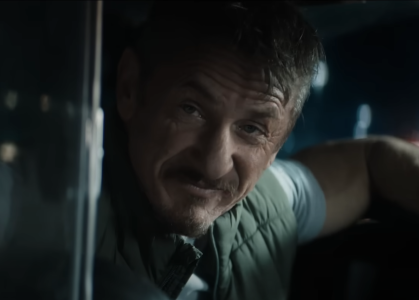 Really Nice Ride
Really Nice RideTo my great surprise and delight, Christy Hall‘s Daddio, which I was remiss in not seeing during last year’s Telluride...
More »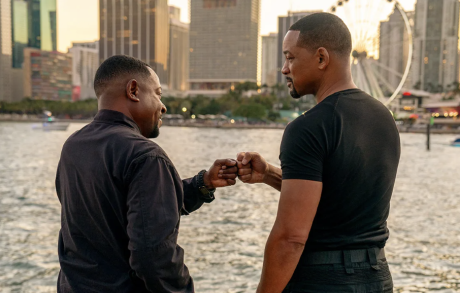 Live-Blogging “Bad Boys: Ride or Die”
Live-Blogging “Bad Boys: Ride or Die”7:45 pm: Okay, the initial light-hearted section (repartee, wedding, hospital, afterlife Joey Pants, healthy diet) was enjoyable, but Jesus, when...
More »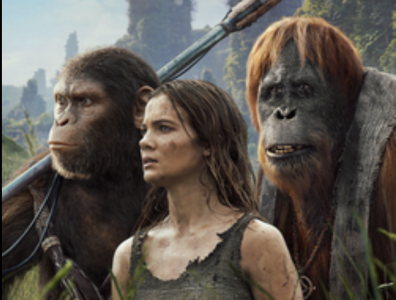 One of the Better Apes Franchise Flicks
One of the Better Apes Franchise FlicksIt took me a full month to see Wes Ball and Josh Friedman‘s Kingdom of the Planet of the Apes...
More »
- The Pull of Exceptional History
The Kamala surge is, I believe, mainly about two things — (a) people feeling lit up or joyful about being...
More » 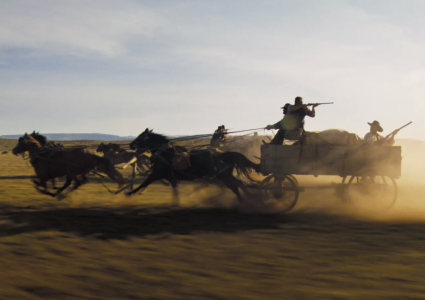 If I Was Costner, I’d Probably Throw In The Towel
If I Was Costner, I’d Probably Throw In The TowelUnless Part Two of Kevin Costner‘s Horizon (Warner Bros., 8.16) somehow improves upon the sluggish initial installment and delivers something...
More » Delicious, Demonic Otto Gross
Delicious, Demonic Otto GrossFor me, A Dangerous Method (2011) is David Cronenberg‘s tastiest and wickedest film — intense, sexually upfront and occasionally arousing...
More »


